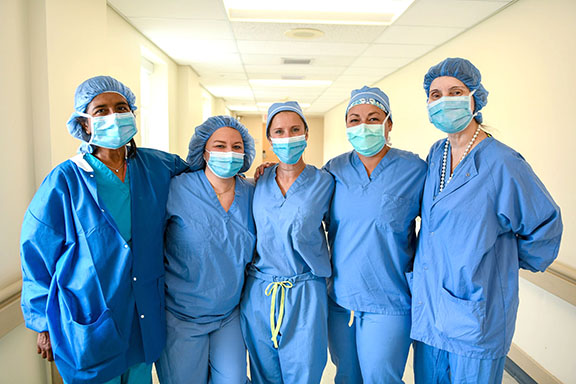
By Judy O’Gorman Alvarez
RED BANK – They may not be the Powerpuff Girls or the Iron Ladies, but on occasion Riverview Medical Center has its own version of surgical sisterhood: Patients may find themselves being tended to by all women in the operating room.
“I don’t know how common it is,” said urogynecologist Lauren Tennyson, M.D., “but when it happens, we’re always just like ‘Yeah!’ ” As Tennyson explained, a surgical team typically consists of the surgeon, surgical assistant, scrub technician, nurse circulator and anesthesiologist.
There are over 24,201 surgeons currently employed in the United States. 48.8% of all surgeons are women, while 51.2% are men.
As a fellowship-trained urologist specializing in female pelvic medicine and reconstructive surgery, Tennyson has expertise in treating a wide range of urogynecologic conditions with special focus on the medical and surgical management of urinary incontinence, voiding dysfunction, pelvic organ prolapse and pelvic pain disorders.
“I do robotic surgery for pelvic organ prolapse and other surgical procedures for urinary incontinence,” she said. “Prolapse and incontinence are my bread and butter.”
Tennyson has been at Riverview Medical Center for two years.
“I didn’t know that I was going to be treating women when I was in residency,” she said. But what she did notice was “there was definitely a need for women urologists to treat women. Because 1 in 10 urologists are women. So, you know, 10% is a low number. And so I recognized that there was a demand for women urologists to treat women.”
According to the American Urological Association, for the first time in history, women urologists surpassed 10% of the urology workforce in 2020. The average annual growth rate from 2014 – 2020 was nearly 9% per year for women compared to approximately 2% per year for men.
Tennyson finds a good number of women, especially when suffering from a condition as personal and possibly embarrassing as urinary incontinence, feel more comfortable being treated by a female physician.
“A lot of women that I see have a lot of nervousness and apprehension about discussing such an intimate issue,” she said. “So I kind of put them at ease and tell them that this is what I do all day long. And these issues are very common. And classically, women didn’t speak about these issues, but now it’s becoming more accepted. And women are just starting to speak about it more. So it’s kind of like a domino effect.”
In some cases, religious restrictions could also play a part in a woman choosing a female urologist, but Tennyson said she has not encountered that.
Having an all-female surgical team may be notable – and appreciated by some patients – but it’s not what Tennyson and her colleagues strive for.
“Because our surgical PA (physician’s assistant) is a woman and it’s not uncommon to have circulators and scrub techs be female,” she said, the lineup occurs from time to time.
At Riverview, there is only one female anesthesiologist on staff, available most days, so odds are low for a completely estrogen-filled OR. And patients, for the most part, may not even be aware of the lineup.
“It has only happened to me one time where the patient cared so much about every single person being female that she specifically even requested a female anesthesiologist. So the one female anesthesiologist took over for that case to be able to satisfy her request. But that doesn’t happen very often at all.”
In fact, Tennyson recently joined with a fellow Riverview urologist Kevin Gioia, M.D., to form their own practice New Jersey Urogyn in Shrewsbury. “While he’s not a female,” she said, “we are partners in this venture. Both my partner and myself are urologists and did fellowships on female pelvic floor reconstruction.”
Overall, no matter the gender, all patients want the best care available to them.
The article originally appeared in the March 2 – 8, 2023 print edition of The Two River Times.














